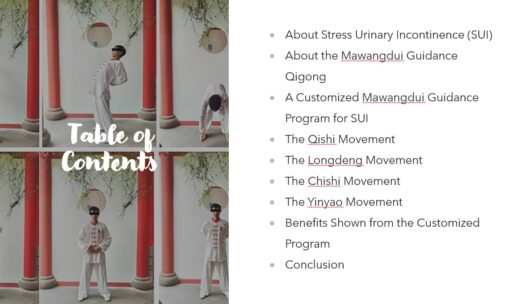Urinary incontinence (UI) is a great problem of public health, especially for women’s quality of life. UI impacts at least 21.6% of the global population, and more than half of the UI is related to female stress urinary incontinence (SUI). One out every three women will experience stress urinary incontinence (SUI) at some point in their life.
Mawangdui Guidance Qigong plays an important role in preventing diseases and maintaining health. Its 12 movements correspond to 12 meridians of traditional Chinese medicine, respectively, and the training of Mawangdui Guidance can not only stimulate acupoints in related meridian but also harmonize the Qi and Blood of the human body.

A tutorial with details is available for ATCQA Members and Certified Instructors/Practitioners.
In a study published by the journal Medicine in April 2024, 60 female patients with SUI were randomly divided into a control group and an experimental group. Patients in both groups were treated with basic rehabilitation therapy under the guidance of rehabilitation therapists who were trained in Mawangdui Guidance. The experimental group was taught to exercise Mawangdui Guidance (including 4 selected movements: “Qishi,” “Longdeng,” “Chishi,” and “Yinyao”), while the control group performed Kegel exercise with a procedure of 20 min, six times per week for 6 weeks.
The function was mainly evaluated by the 1 h pad-test, incontinence quality of life questionnaire (I-QOL), and international consultation on incontinence questionnaire urinary incontinence short form (ICI-Q-SF). In addition, evaluation of pelvic floor muscle function was also included in our assessment.

The Table of the Contents of the tutorial with details
At the end of the study, the leakage of urine in the 1-hour pad-test was significantly decreased in both two groups after treatment, and the urine leakage in the experimental group was significantly less than that in the control group.
The muscle strength of type I and II muscle fibers of the pelvic floor, intravaginal pressure, and I-QOL score in both two groups were increased after treatment; moreover, the experimental group was more significant than the control group.
The fatigue degree of type I and type II muscle fibers of the pelvic floor, and the ICI-Q-SF score in both groups were significantly improved after treatment; however, there were no differences between these two groups.
Conclusion: 4 of the 12 movements in Mawangdui Guidance can effectively improve the function of pelvic floor muscle, improve the ability of urine storage and control, and alleviate the symptoms of female patients with SUI. However, the international research on Mawangdui Guidance is very limited, and more in-depth research is needed.